
Indoor Ficus : Growing and Caring for Your Plant
Contents
The Ficus in a nutshell
- Indoor Ficus plants are robust decorative plants, ideal for adding an elegant touch of greenery.
- There is a wide range of species and varieties to suit all tastes.
- They prefer indirect light and moderate watering with good ambient humidity.
- A well-draining substrate and regular care (misting, dusting) promote their health.
- Easy to propagate by cuttings or layering, they adapt to all interior styles.
The word from our expert
Indoor Ficus plants are must-haves for adding an elegant and exotic touch of greenery to our living spaces. They encompass a variety of species, such as the Ficus elastica with its thick, glossy leaves, the Ficus lyrata with its large veined leaves, or the delicate Ficus benjamina with its graceful trailing habit. Native to tropical and subtropical regions, these plants adapt perfectly to bright indoor environments. Their dense, evergreen foliage makes them ideal allies for creating a natural and soothing atmosphere.
Easy to grow, ficus plants thrive in bright, indirect light, moderate watering, and a slightly humid environment. Species with broad leaves, such as the Fiddle Leaf Fig or the Rubber Plant, benefit from regular dusting or light misting to maintain their shine. A pot with good drainage and a light, airy substrate is essential to prevent root-related diseases. Additionally, gentle fertilisation in spring and summer promotes vigorous growth, while occasional pruning helps shape their habit.
Ficus plants may be susceptible to attacks from scale insects, spider mites, or diseases related to humidity, such as root rot. Regular monitoring and proper care can prevent these issues. For propagation, enthusiasts can easily propagate them by cuttings or air layering, simple and effective methods to obtain new plants.
True chameleons of interior design, ficus plants blend harmoniously into all interior styles, from minimalist to bohemian, including industrial settings. Placed in ceramic pots, wicker baskets, or concrete planters, they become focal points of décor. Versatile and majestic, ficus plants are much more than mere houseplants: they embody elegant, living nature that enhances every space.
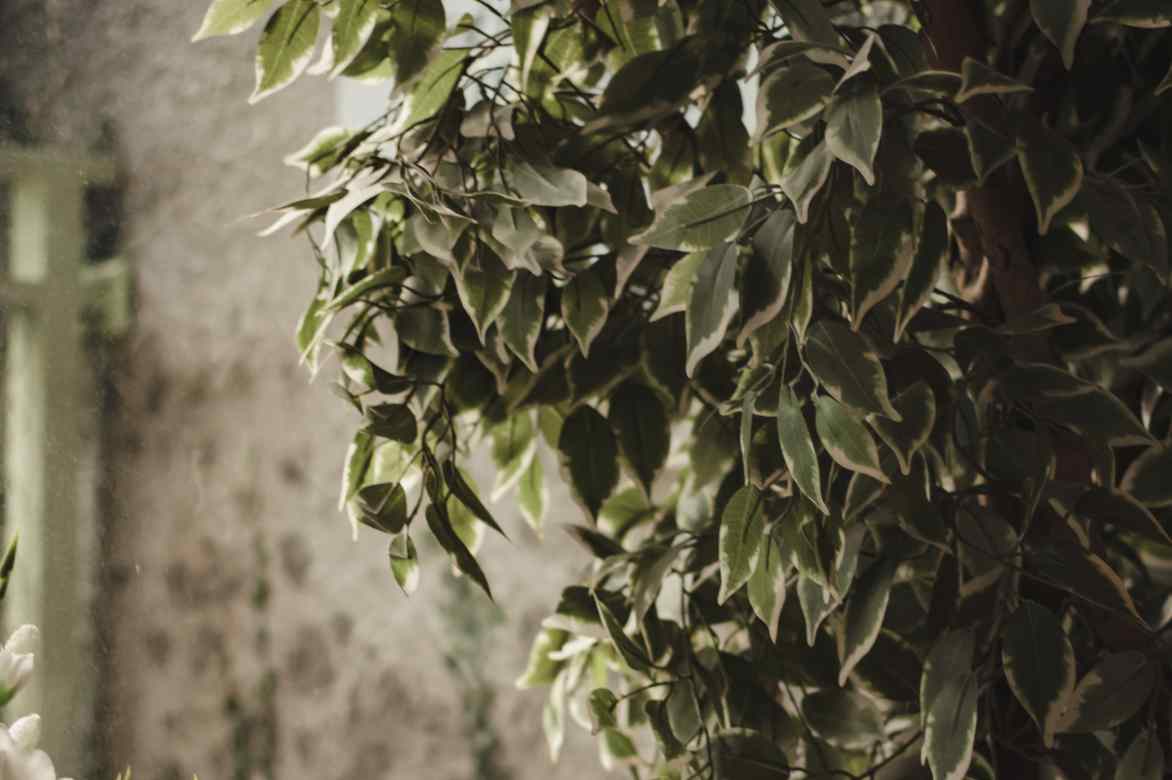
Ficus benjamina
Botany and description
Botanical data
- Latin name Ficus sp.
- Family Moraceae
- Common name Ficus, Weeping Fig, Fiddle-leaf Fig, Rubber Plant...
- Flowering year-round, but insignificant
- Height up to 3 m in pots
- Exposure bright, indirect light
- Soil type rich, well-draining soil
- Hardiness 15°C
The Ficus belongs to the large Moraceae family, a botanical family that includes plants with very diverse forms, ranging from majestic trees to small creeping plants. The genus name Ficus comes directly from Latin, meaning “fig tree,” and refers to the Ficus carica, the common fig tree, cultivated for its fruit in our gardens. However, this vast genus includes over 800 species, some of which are well-known under French names such as the weeping fig (Ficus benjamina), the rubber plant (Ficus elastica), the fiddle-leaf fig (Ficus lyrata), or the creeping fig (Ficus pumila).
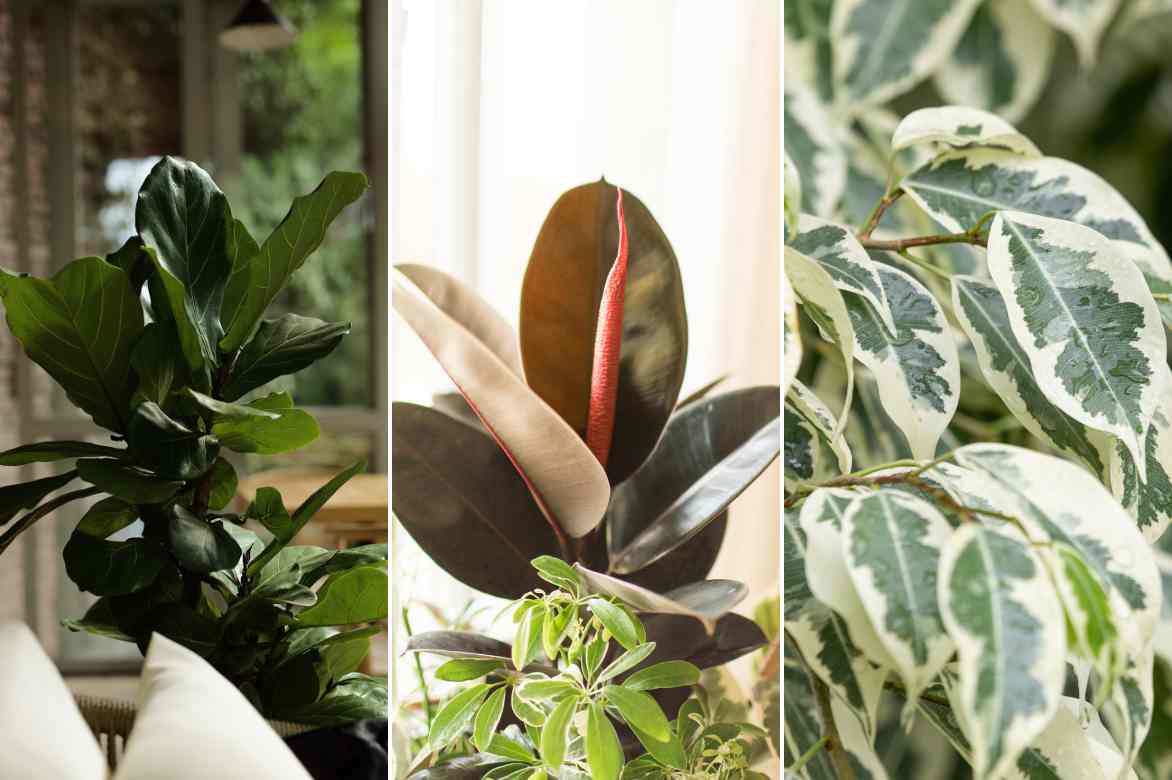
Ficus lyrata, Ficus elastica, and Ficus benjamina
In their natural habitat, indoor ficus plants thrive primarily in tropical and subtropical forests in Asia, Africa, and the Americas. They grow in warm, humid environments, often in the shade of larger trees, climbing or spreading depending on the species. Some, like the Ficus benghalensis, can even become giants by spreading through their aerial roots, forming entire forests on their own.

The banyan or Ficus benghalensis
It is precisely this adaptability that makes the ficus such a popular houseplant. It adds an exotic and lush touch to living spaces with its dense, decorative foliage. Moreover, the Ficus adapts relatively well to indoor conditions, tolerating indirect light and the drier atmospheres of homes. Its diversity of species allows for a choice of varied forms, glossy or textured foliage, to suit all decoration styles, from the most classic to the most modern.
A moody plant! The Ficus benjamina is famous for its sensitivity to change. If moved or subjected to sudden changes (such as drafts or irregular watering), it can lose a large number of its leaves overnight. This often gives the impression that it is “sulking.” But don’t worry! This is its way of adapting, and it will regrow leaves once properly acclimated.
Some beautiful varieties to welcome into your home
The Ficus benjamina ‘Natasja’ is a more compact and bushy version of the classic weeping fig. Its dense foliage of small, glossy green leaves gives it an elegant and tidy appearance. Thanks to its smaller size and moderate growth, it is ideal for small spaces or as an office plant.
The Ficus elastica ‘Schrijveriana’ is an impressive cultivar of the traditional rubber plant. Its large, thick leaves feature marbled patterns of light green and cream, creating a spectacular contrast. In addition to its aesthetic appeal, it shares the robustness of other Ficus elastica, adapting well to medium-light conditions and tolerating occasional missed waterings.
The Ficus pumila ‘Arina’, often nicknamed the dwarf fig or creeping fig, is an adorable climbing or trailing plant. Its small, dark green, thick, and glossy leaves offer a very decorative carpeting effect. The Ficus pumila ‘Bellus’, on the other hand, stands out for its more textured foliage. Its leaves are slightly undulate and feature lighter edges, adding depth to the plant.
Watch out for invasiveness! The Ficus elastica or rubber plant can grow very large if left unchecked. It is not uncommon for owners to neglect pruning their ficus and end up with a tree that touches the ceiling! Its roots can even attempt to spread into neighboring pots or lift tiles if the plant is in a massive pot. It’s a true force of nature, even indoors!
Botanical description of Ficus
It is difficult to generalize a description that would apply to all Ficus, as the genus is so diverse.
Tropical and subtropical Ficus form a group of very different plants, ranging from small creeping ground covers to majestic century-old trees. Their general habit varies greatly depending on the species: some, like the Ficus benjamina, adopt an elegant silhouette with slightly trailing branches that create a light effect. Others, like the Ficus elastica, have a more upright and robust habit with thick branches and a well-defined trunk. Species such as the Ficus benghalensis (banyan fig) have spectacular growth thanks to their widely spreading branches, supported by aerial roots that become secondary trunks.
The root system of Ficus in nature is particularly impressive. Many species develop aerial roots that descend from branches and anchor into the soil, allowing the tree to spread horizontally and create monumental structures, as seen in the Ficus benghalensis. Others, like the Ficus elastica, have robust and deep roots that stabilize massive trunks. These roots are not only structural but also help capture moisture from the air, an advantage in tropical environments.
The foliage of ficus is another key element of their appeal. It is generally evergreen, providing year-round cover. The leaves vary by species: the Ficus elastica boasts large, ovate, thick, and glossy leaves, often edged with red veins, while the Ficus lyrata is recognizable by its broad, lyre-shaped, veined, and leathery leaves. The Ficus pumila, on the other hand, has small, ovate, thin, and slightly textured leaves. This lush foliage is not only decorative but also adapted to their natural environment, limiting water loss thanks to their thick, waxy texture.
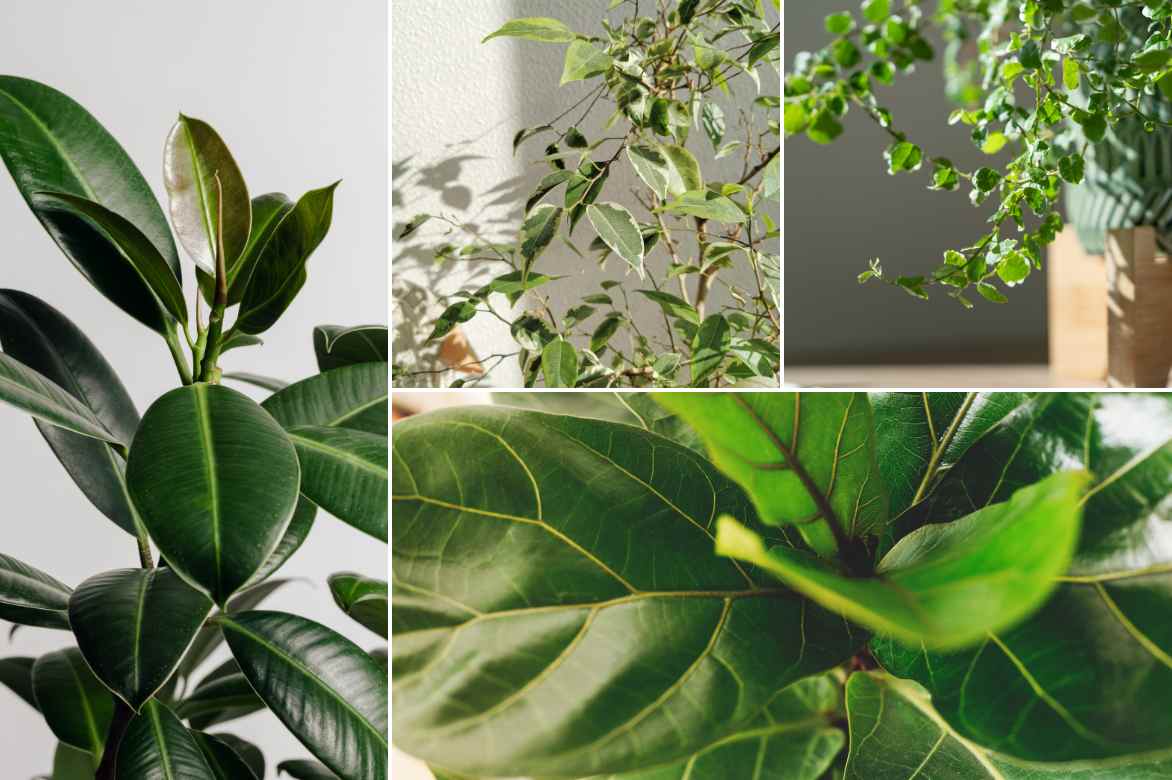
Ficus elastica, Ficus benjamina, Ficus pumila, and Ficus lyrata
The flowering of ficus, however, is discreet, almost insignificant. They do not produce showy flowers like other plants, as their flowers are enclosed inside small fig-like structures called syconia. Inside these syconia are tiny flowers that often require specific insects, such as certain wasp species, for pollination. This flowering goes unnoticed to the naked eye and typically lasts a few weeks. In ornamental species grown indoors, flowering is rare, as conditions are not ideal for its formation.
Good to know: the Ficus elastica was identified by the famous NASA study as a plant capable of purifying indoor air. It absorbs certain toxins like formaldehyde and improves air quality.
Beware of the latex!
The latex that oozes from the branches of indoor ficus is a thick, white sap. This liquid appears when the plant is injured, for example after pruning or if a branch or leaf is broken. This phenomenon is particularly visible in species like the Ficus elastica and the Ficus benjamina.
This latex is not merely decorative or harmless: it plays a natural protective role for the plant. When an injury occurs, the sap flows to quickly seal the wound, preventing the entry of pathogens or parasites. This sap contains rubbery compounds (hence the name Ficus elastica) that form a protective barrier.
However, this latex is also toxic and can cause skin irritation. It contains enzymes and chemical compounds like furocoumarins and allergenic proteins that can irritate the skin and mucous membranes. Direct contact can lead to redness, itching, or even minor burns. In sensitive or allergic individuals, it may cause more pronounced reactions. If the latex comes into contact with the eyes, it can even cause painful inflammation.
It is therefore recommended to wear gloves when pruning or maintaining ficus to avoid any contact with this sap. If latex touches the skin, it is best to rinse immediately with clean water and soap. As for pets, keep them away from this sap, as it can also be toxic if ingested.
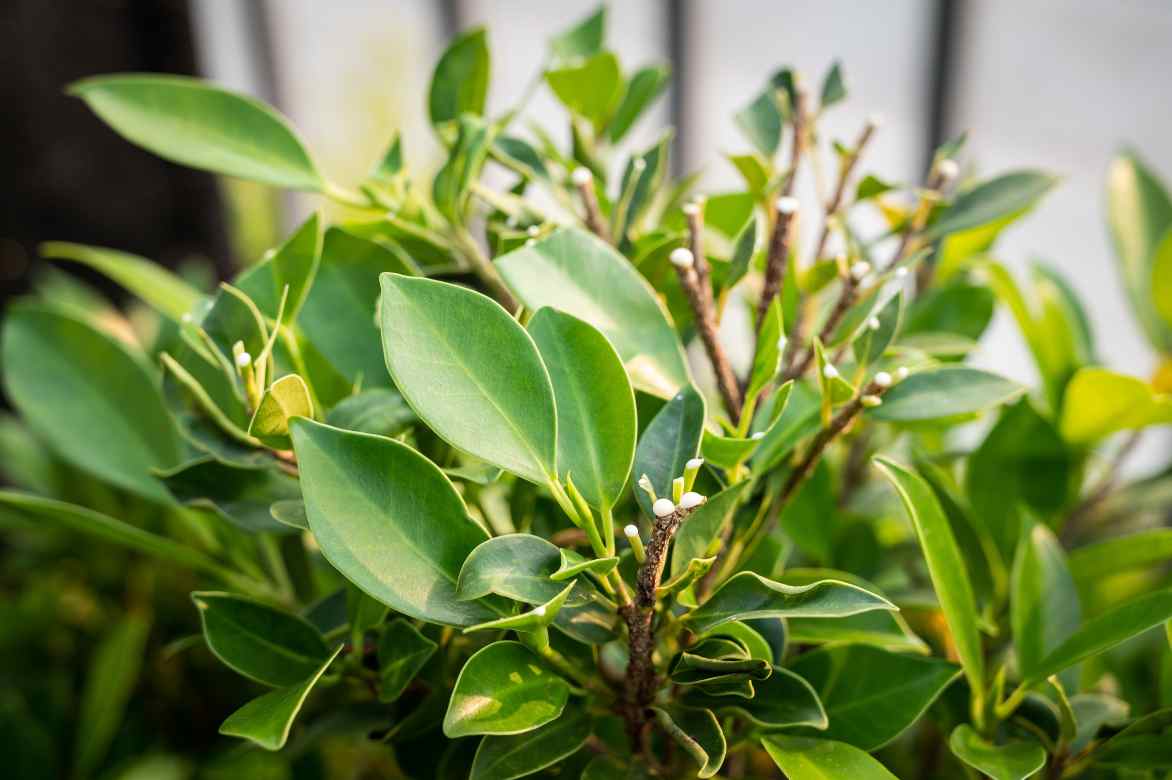
Planting and positioning
Exposure
- Bright without direct sunlight: ficus plants love light, but they dislike direct rays of the sun, which can scorch their leaves.
- Near an east or west-facing window: gentle, indirect light is ideal.
- Avoid draughts and sudden temperature changes, as these can cause the leaves to drop.
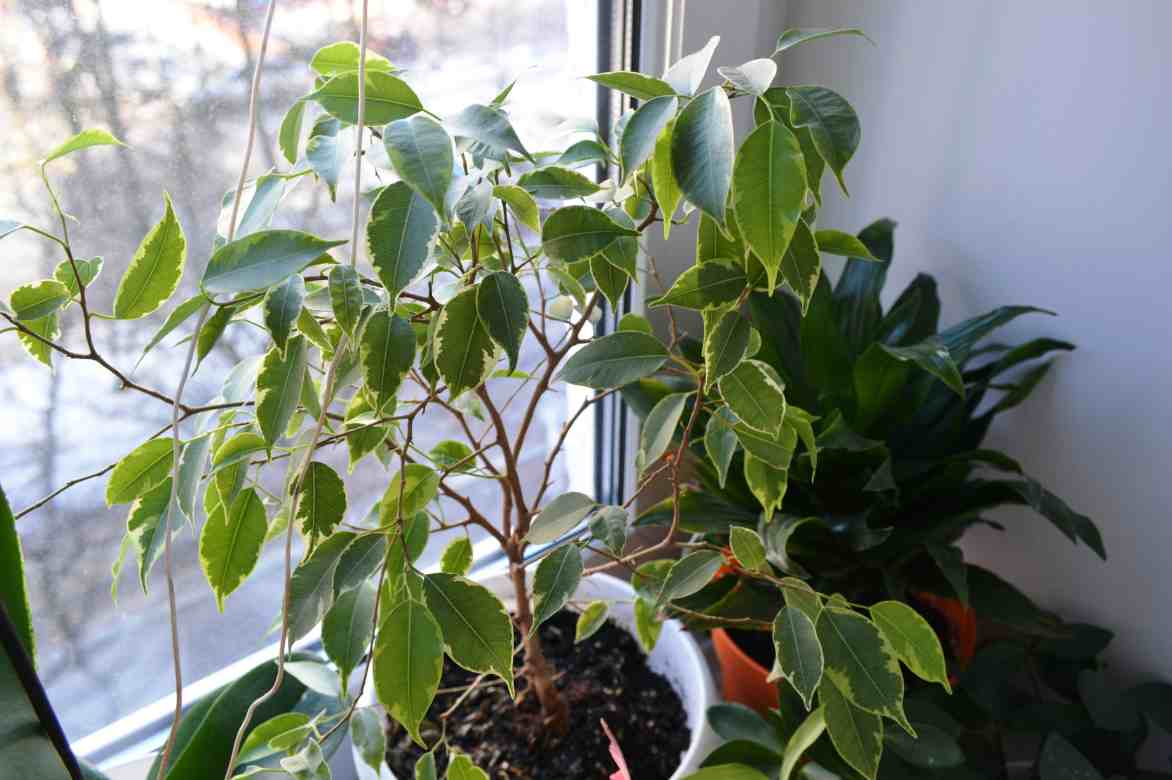
Type of Pot
- Pot with drainage holes to prevent water accumulation and avoid root rot.
- Appropriate size: neither too large nor too small. The pot should provide space for the roots without being disproportionate.
- Material: terracotta (good aeration) or plastic (lighter but retains more moisture).
Type of Substrate
- Well-draining substrate: a mix of 2/3 universal potting compost and 1/3 sand or perlite to promote aeration.
- Ready-to-use option: a special houseplant compost works very well.
Repotting
- Every 2 to 3 years in spring, when the roots start to emerge from the drainage holes or growth slows down.
- Change the pot for a slightly larger container or simply renew the top layer of compost each year (top-dressing).
How to grow and care for a Ficus?
Watering
- Moderate: water when the top 2-3 cm of soil are dry.
- In summer: approximately once a week.
- In winter: reduce to once every 2-3 weeks.
- Avoid stagnant water: remember to always empty the saucer after watering.
Please note: as with many houseplants, misting is essential for the well-being of the Ficus, especially in winter with heating. A lack of ambient humidity can cause dry leaves, brown tips, or even leaf drop. It is recommended to mist the foliage with non-calcareous water at room temperature, once or twice a week, avoiding over-wetting the young shoots.
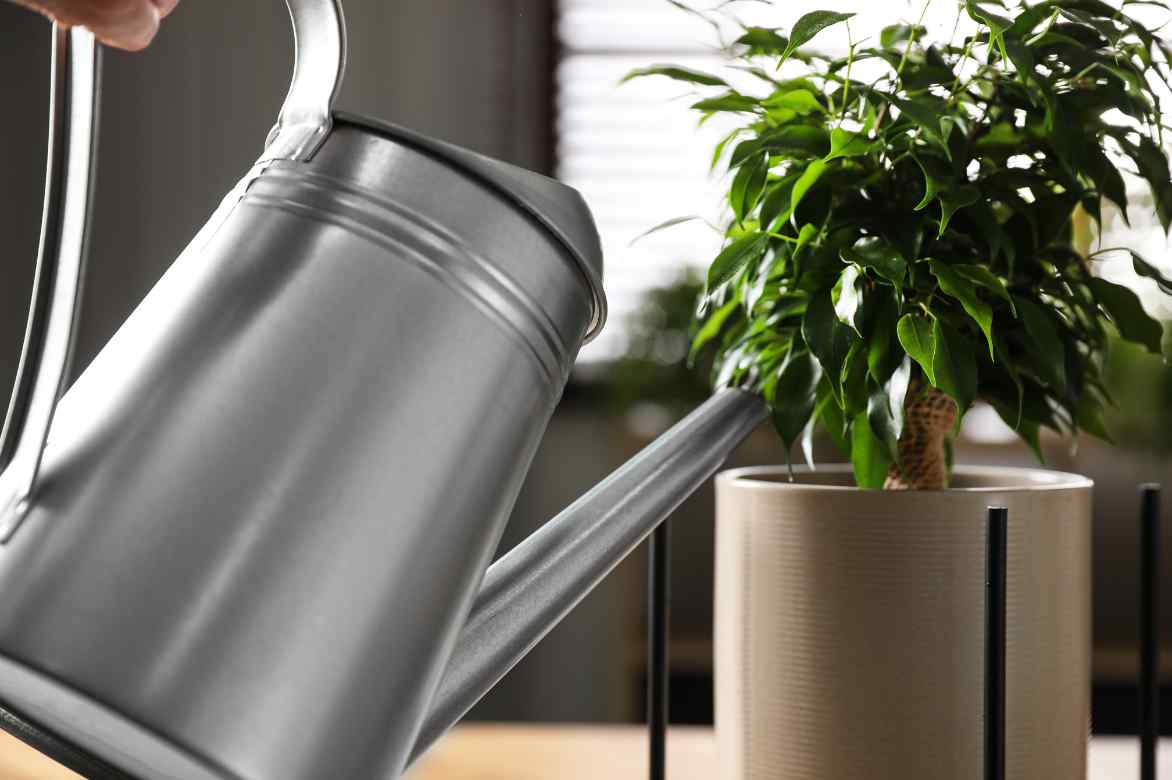
Fertilisation
- From April to September: apply liquid fertiliser for green plants every 2 to 4 weeks.
- In winter: no need to fertilise, as the plant is in dormancy.
Pruning
- In spring or early summer: just to control size and shape.
- Cut back troublesome or damaged branches with clean scissors.
- Pinch young shoots to encourage a bushier habit.
Warning! The latex can be irritating. Remember to wear gloves or wash your hands thoroughly afterwards.
Repotting
- Every 2 to 3 years in spring, when the roots start to emerge from the drainage holes or growth slows down.
- Change the pot to a slightly larger container or simply renew the top layer of compost each year (top-dressing).
Dusting
For Ficus with large foliage, such as Ficus elastica or Ficus lyrata, it is recommended to regularly dust the leaves with a soft, damp cloth to promote photosynthesis and maintain their glossy appearance. This also helps prevent the appearance of parasites that like to hide on dirty leaves.
Additionally, taking houseplants outside during a gentle summer rain is a great way to naturally clean the foliage, especially for the small leaves of a Ficus benjamina, for example.
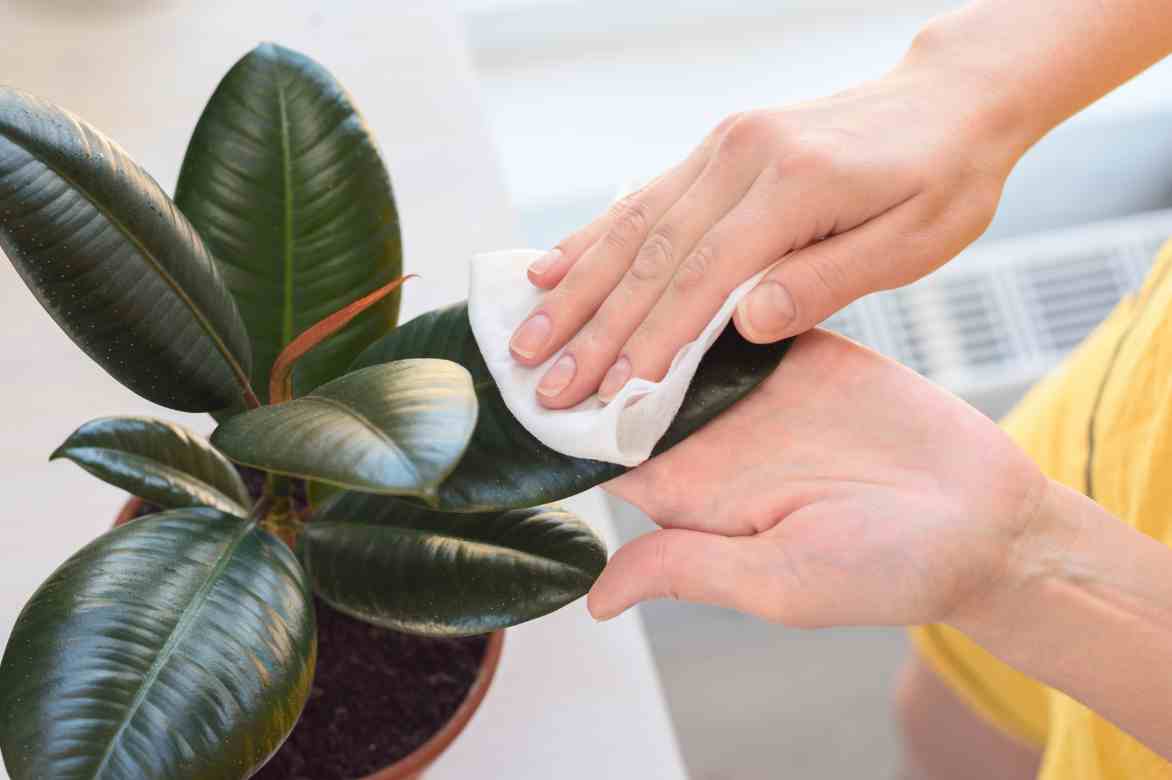
Diseases and potential parasitic issues
Indoor Ficus plants are generally robust, but they can be susceptible to certain diseases and attacked by various parasitic organisms, especially when their growing conditions are not optimal.
Common Diseases
- Root rot: Caused by overwatering or poor drainage, it manifests as yellowing and falling leaves, as well as a soft trunk. The roots turn black and emit an unpleasant odour.
- Powdery mildew: This fungal disease is recognisable by a white powdery deposit on the leaves. It often appears in overly humid and poorly ventilated environments.
- Leaf spots: Brown or black spots appear on the leaves, caused by fungi or bacteria. Excessive humidity encourages their development.
Common Parasites
- Scale insects: These small brown or white insects, shaped like tiny domes or cottony patches, settle on stems and the undersides of leaves, sucking the plant’s sap. They leave sticky traces called honeydew, which can lead to the appearance of sooty mould (a black fungus).
- Spider mites: Tiny and difficult to see with the naked eye, they weave fine webs on the leaves and cause yellow spots before the leaves dry out. They thrive in warm, dry atmospheres.
- Aphids: These small green, black, or yellow insects colonise young shoots and also excrete honeydew, attracting ants and sooty mould.
- Thrips: These elongated insects leave silvery streaks and distort the leaves by piercing them to extract sap.
- Fungus gnats (sciarid flies): Although less dangerous, these small black insects appear when the substrate is too damp. Their larvae may eventually attack young roots.
Prevention and Treatments
- Avoid overwatering and ensure the pot has good drainage.
- Ventilate the room regularly to reduce stagnant humidity.
- Clean the leaves with a damp cloth to prevent parasites from settling.
- For mild infestations, use diluted black soap or nettle purin.
How to propagate Ficus plants?
Propagating Ficus is relatively straightforward and can be done using two methods, depending on the species and the gardener’s preferences: propagation by cuttings or air layering.
Propagation by Cuttings (the simplest method)
Ideal time: in spring or early summer, when the plant is in full growth.
Steps:
- Take a healthy stem of 10 to 15 cm, bearing 2 to 3 leaves. Choose a semi-woody stem (neither too soft nor too hard).
- Cut below a node with clean pruning shears. Remove the lower leaves to keep only the upper ones.
- Stop the latex flow by dipping the base in lukewarm water for a few minutes or by dabbing with a cloth.
- Plant the cutting in a pot filled with a light and well-draining mix (compost + sand or perlite).
- Lightly moisten the substrate without soaking it.
- Cover with a transparent plastic bag or a mini greenhouse to create a greenhouse effect (closed cutting).
- Place in indirect light and keep the substrate moist.
- Wait 4 to 8 weeks: roots should appear. When new leaves grow, the cutting is ready to be repotted.
Air Layering (ideal for large Ficus like Ficus elastica or Ficus lyrata)
Ideal time: in spring or summer.
Steps:
- Choose a vigorous branch and remove the leaves over a 10 cm area around a node.
- Make a slight incision in the bark by creating two small parallel cuts and remove the bark between them.
- Wrap the area with damp sphagnum moss, then cover it with plastic film or a transparent bag to retain moisture.
- Seal the ends with ties to prevent evaporation.
- Monitor the moisture of the sphagnum moss. After 1 to 2 months, roots will appear.
- Once well-rooted, cut below the root ball and plant the new plant in a suitable pot.
General Tips
- Always use clean and disinfected tools to avoid infections.
- Maintain regular moisture without excess water to prevent rot.
- Do not expose young plants to direct sunlight, but to gentle light.
- Be patient: Ficus can sometimes take several weeks to show signs of recovery.
How to showcase a Ficus?
The Ficus is an extremely versatile plant that adapts to many interior decoration styles. Its lush foliage and varied shapes allow it to blend seamlessly into both modern and more natural settings. Here are some decor ideas tailored to different species of ficus and the types of pots that will showcase them best:
Ficus elastica (Rubber Plant)
- Interior style: perfect for modern, industrial, or minimalist interiors. Its thick, glossy leaves add a graphic and elegant touch.
- Pot type: a matte or glossy ceramic planter in neutral tones (white, black, grey) or concrete for an industrial effect. A brass or copper metal pot can also enhance its chic appeal in a more sophisticated interior.
- Placement: near a large window or in a corner to occupy vertical space.
Ficus lyrata (Fiddle Leaf Fig)
- Interior style: ideal for Scandinavian, bohemian, or contemporary decors thanks to its large, sculptural leaves. It quickly becomes a focal point.
- Pot type: a wicker or jute basket for a natural and bohemian vibe. In a more pared-down interior, a terracotta or light concrete pot accentuates its design appeal.
- Placement: isolated in a bright corner or near a sofa, it structures the space with elegance.
Ficus benjamina (Weeping Fig)
- Interior style: highly versatile, it suits classic, cosy, or even vintage decors with its trailing and airy habit.
- Pot type: a glazed ceramic pot with subtle patterns or a colourful planter to liven up the decor. A wooden pot on legs can also highlight its delicate silhouette.
- Placement: near a sheer-curtained window or in a spacious entryway, it adds softness and volume.
Ficus pumila (Creeping Fig)
- Interior style: perfect for plant-filled, urban, or rustic decors. Its dense and delicate foliage is ideal for dressing up shelves or walls.
- Pot type: a macramé hanger for a bohemian vibe or a wall-mounted terracotta pot to create a living wall. A raw concrete or transparent glass pot also showcases its fine roots.
- Placement: hung near a window or placed on a shelf to let its stems trail elegantly.
Ficus microcarpa ‘Ginseng’ (Bonsai)
- Interior style: ideal for zen, minimalist, or Asian interiors, thanks to its nodose trunk and small leaves.
- Pot type: a sober glazed ceramic pot, often oval or rectangular in shape, highlights its aerial roots. Subdued colours like black, anthracite grey, or terracotta tones are perfect.
- Placement: on a console or well-lit shelf, it immediately catches the eye.
General Decor Tips
- Pairing the ficus with other plants creates a soothing green corner.
- Vary the heights by combining floor pots, elevated pots, or hanging planters to add depth.
- Choose natural materials (wicker, wood, ceramic) to enhance the plant-filled vibe or raw materials (concrete, metal) for a more contemporary effect.
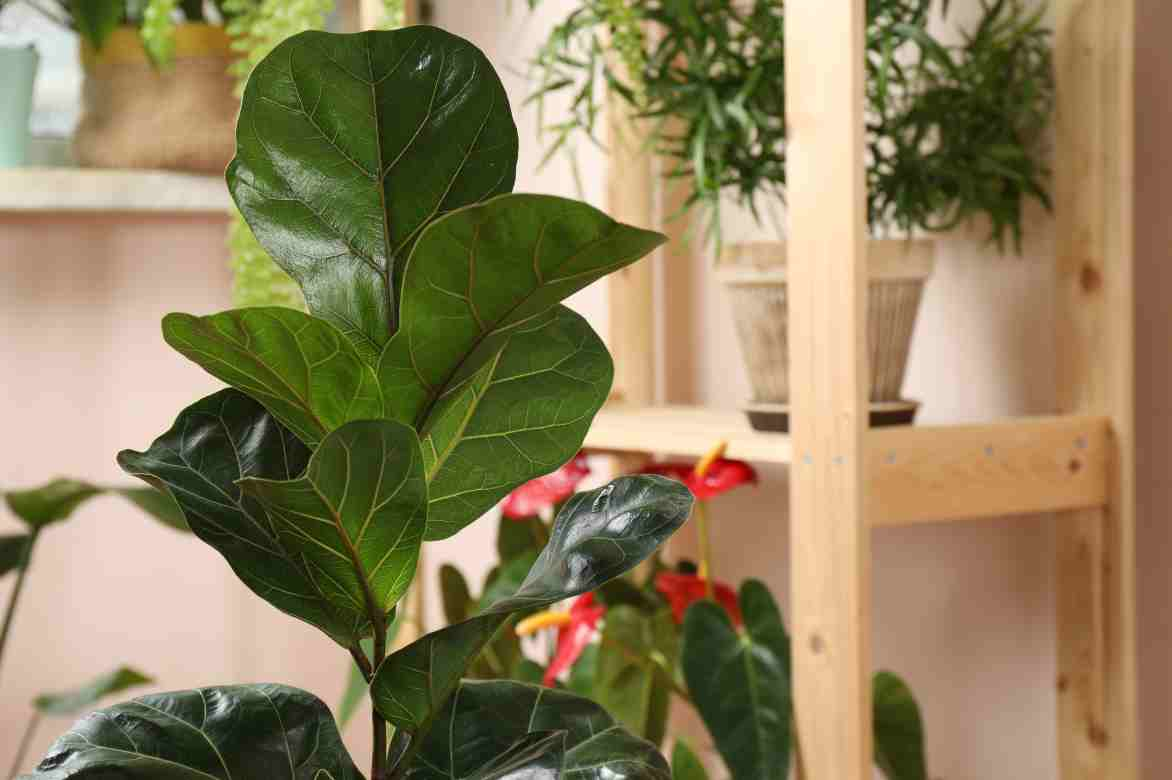
Also worth reading
→ Discover our care tips in our article: The Ficus Through the Seasons.
→ Explore our wide range of houseplants.
- Subscribe!
- Contents
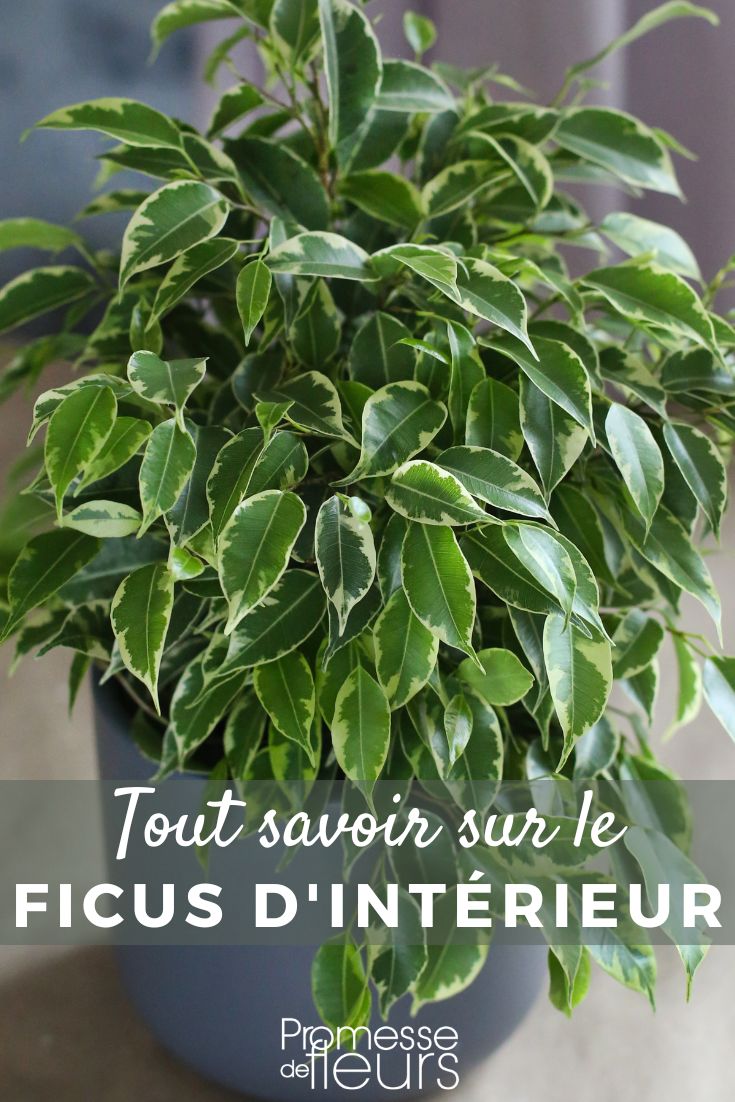































Comments